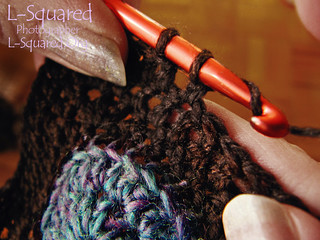In my many crochet project posts, I do make an effort to point out patterns that I find to be especially nicely tactile for my fellow blind/visually impaired crocheter friends who might be reading the blog. However, today I received a comment (thanks Terry!) at my personal website, which essentially pointed out to me that I haven’t blogged in any detail about how to actually go about identifying stitches by touch, for those who are new to crochet.
How easily you will be able to distinguish crocheted stitches by feeling them is highly dependent on your yarn weight and your hook size. Smaller stitches (like single crochet and slip stitches), especially those made with thinner weight yarns (sport, sock/fingering, thread, etc), special-textured yarns (like fun fur or fleece) and/or smaller hooks (F or less) will be more challenging, even for the experienced crocheter, to pick out individually than the larger/taller stitches. So, assuming you already know how to make each of the basic stitches in crochet (chain, slip stitch, single crochet, half double crochet, double crochet, and possibly even triple/treble crochet - I'm using U.S. terms here), then I would recommend you practice identifying the stitch structures by working each of these most common stitches in a swatch with a relatively thick yarn using a large crochet hook. A block of double crochets made with worsted or bulky yarn on a J, K or bigger sized hook, should be good to begin with since that's a larger/taller and thus more tactile stitch. After you become more comfortable identifying the various stitch types and their structures made with larger hooks and thicker yarns, then gradually start practicing identifying stitches worked with the smaller hooks and/or thinner yarns you may eventually want to work with for a project.
As you are feeling for stitches, if you have any remaining vision or if you previously had vision when you learned to crochet, try to match up what you think/know the stitches should look like visually with what you are feeling under your fingertips. As I am working, I typically feel each stitch in my project simultaneously with my thumb (on the front side) and my index finger (on the back side). It is typically the light touch of my index finger pressing the stitch against my stable thumb that makes quick identification possible for me. Other crocheters may accomplish this task differently, for example: by laying their work out on a flat surface and running an index finger or multiple fingers over it, similar to the manner in which Braille is read. Do whatever works best for you.
If you don't have any idea what crocheted stitches look like, then start with the basics - the top of pretty much every stitch is made up of two loops, the front loop and the back loop, which together form a hole in which you typically work the next row/round of stitches. Below this, most stitches (like double crochet) have a notable "post" structure which will be a different size/shape depending on the stitch. Each type of crochet stitch does feel distinctly different (ex. to me, single crochet basically just feels like small holes in the middle of yarn boxes, the post of half-double crochet feels fat/thick, the double crochet post is tall and skinnier than hdc, triple crochet's post is very tall). It just takes a little practice to learn what each one feels like.
The key to feeling stitches in crochet really is practice - how and when you do that (i.e. with swatches before you begin a project or with a project itself, as you are creating it) is up to you. I learned how to crochet at a young age, so now, 20-some years later, it seems natural to me to pick out the various stitch structure details by touch as I work. However, it is a skill I mastered thanks to practice with many different types of crochet projects.

No comments:
New comments are not allowed.